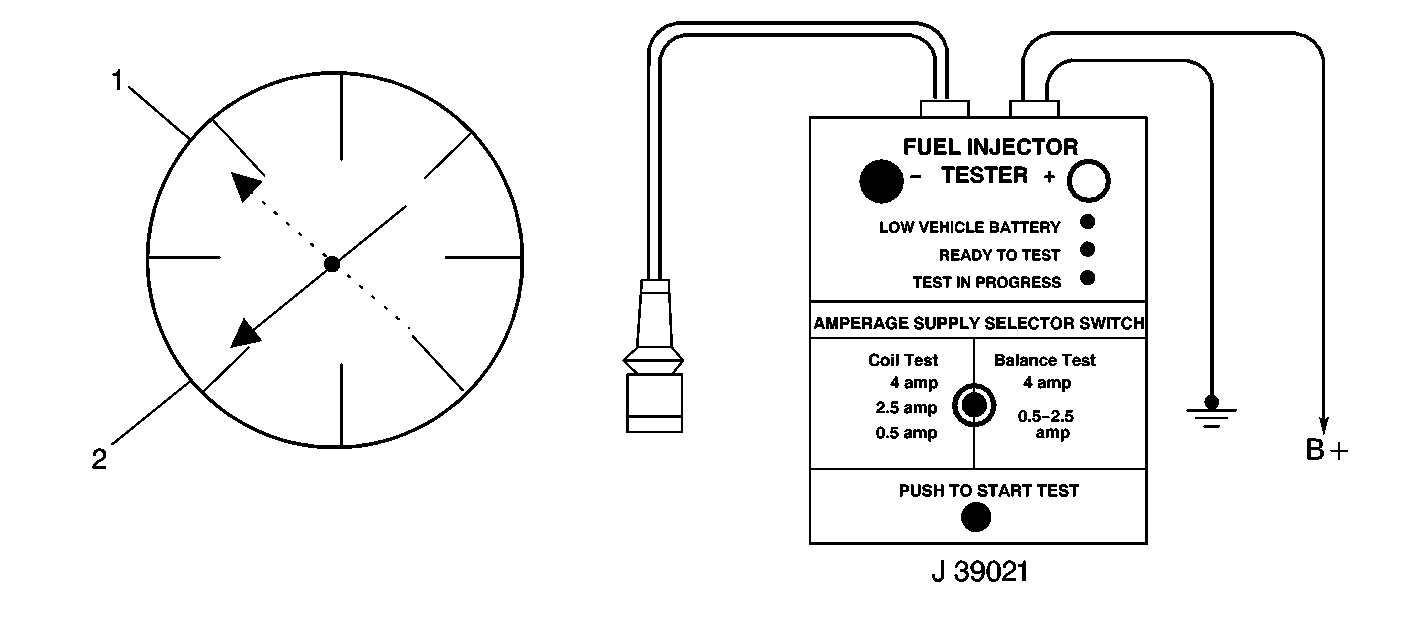Step
| Action
| Value(s)
| Yes
| No
|
1
| Did you perform the Powertrain On-Board Diagnostic (OBD) System Check?
| --
|
Go to Step 2
| Go to
Powertrain On Board Diagnostic (OBD) System Check
|
2
| Did you perform the Fuel Injector Coil Test Procedure?
| --
|
Go to Step 3
| Go to
Fuel Injector Solenoid Coil Test - Engine Coolant Temperature Between 10-35 Degrees C (50-95 Degrees F)
|
3
| Is the engine coolant temperature above the specified value?
| 94°C (201°F)
|
Go to Step 4
|
Go to Step 5
|
4
| Allow the engine to cool below the specified value.
Is the engine coolant temperature below the specified value?
| 94°C (201°F)
|
Go to Step 5
| --
|
5
|
Caution: Wrap a shop towel around the fuel pressure connection in order to reduce
the risk of fire and personal injury. The towel will absorb any fuel leakage
that occurs during the connection of the fuel pressure gage. Place the towel
in an approved container when the connection of the fuel pressure gage
is complete.
- Turn OFF the ignition.
- Connect the J 34730-1A
fuel pressure gauge to the fuel pressure test port.
- Turn ON the ignition leaving the engine OFF.
- Install the scan tool.
- Energize the fuel pump using the scan tool.
- Place the bleed hose of the fuel pressure gauge into an approved gasoline
container.
- Bleed the air out of the fuel pressure gauge.
- Again energize the fuel pump using the scan tool.
- Wait for the fuel pressure to build.
Important: The fuel pump will run for approximately
2 seconds. Repeat step 8 as necessary in order to achieve the highest possible
fuel pressure.
- Observe the reading on the fuel pressure gauge while the fuel pump is
running.
Is the fuel pressure within the specified limits?
| 379-427 kPa (55-62 psi)
|
Go to Step 6
| Go to
Fuel System Diagnosis
|
6
| After the fuel pump stops, the fuel pressure may vary slightly, then should
hold steady.
Does the fuel pressure remain constant within the specified value?
| 379-427 kPa (55-62 psi)
|
Go to Step 7
| Go to
Fuel System Diagnosis
|
7
|
- Connect the J 39021 fuel injector tester to a fuel injector using
the J 39021-380 injector test adapter.
- Set the amperage supply selector switch on the fuel injector tester to
the balance test 0.5-2.5 amp position.
- Energize the fuel pump using the scan tool in order to pressurize the
fuel system.
- Record the fuel pressure indicated by the fuel pressure gauge after the
fuel pressure stabilizes. This is the 1st pressure reading (1).
- Energize the fuel injector by depressing the Push to Start Test button
on the fuel injector tester.
- Record the fuel pressure indicated by the fuel pressure gauge after the
fuel pressure gauge needle has stopped moving. This is the 2nd pressure reading
(2).
- Repeat steps 1 through 6 for each fuel injector.
- Subtract the 2nd pressure reading from the 1st pressure reading for one
fuel injector. The result is the pressure drop value.
- Obtain a pressure drop value for each fuel injector.
- Add all of the individual pressure drop values. This is the total pressure
drop.
- Divide the total pressure drop by the number of fuel injectors. This
is the average pressure drop.
Does any fuel injector have a pressure drop value that is either higher than
the average pressure drop or lower than the average pressure drop by the specified
value?
| 10 kPa (1.5 psi)
|
Go to Step 8
| Go to
Symptoms
|
8
|
Notice: Do not repeat any portion of this test before running the engine in
order to prevent the engine from flooding.
Retest any fuel injector that does not meet the specification. Refer to the
procedure in step 7.
Does any fuel injector still have a pressure drop value that is either higher
than the average pressure drop or lower than the average pressure drop by the
specified value?
| 10 kPa (1.5 psi)
|
Go to Step 9
| Go to
Symptoms
|
9
| Perform the
Fuel Injector Cleaning
.
Did you complete the procedure?
| --
|
Go to Step 10
| --
|
10
| Operate the system in order to verify the repair.
Did yo correct the condition?
| --
| System OK
| Go to
Symptoms
|
